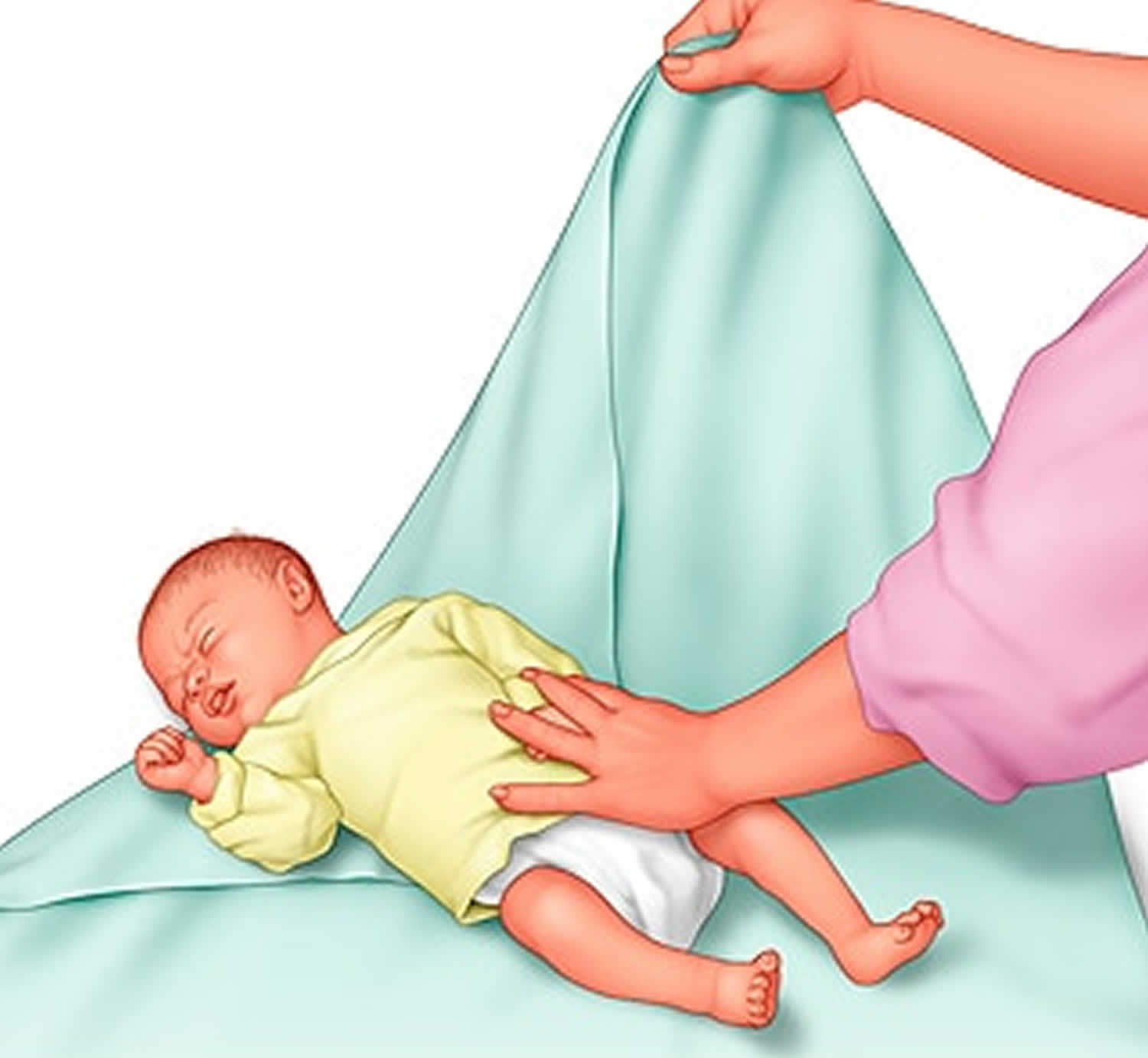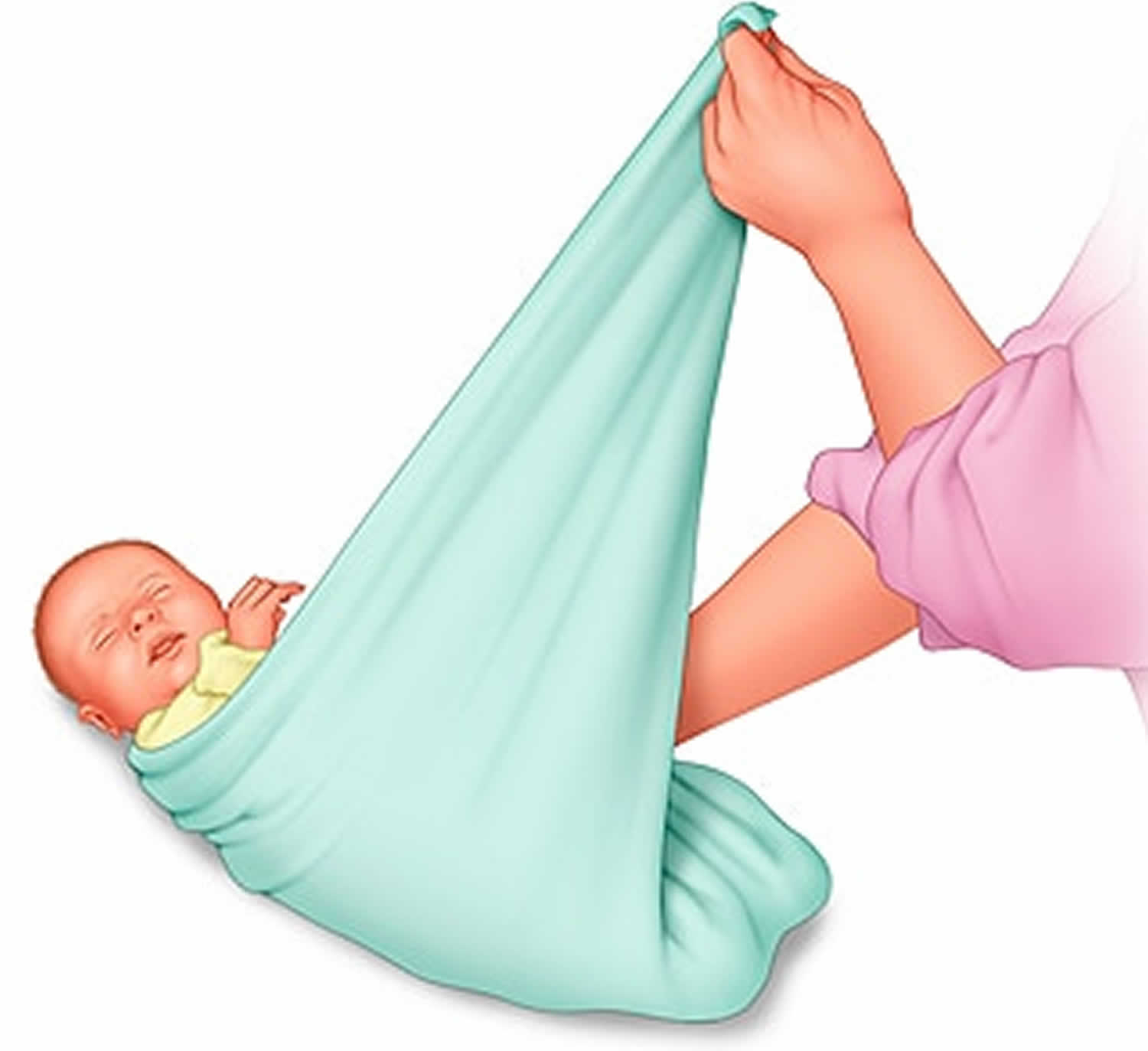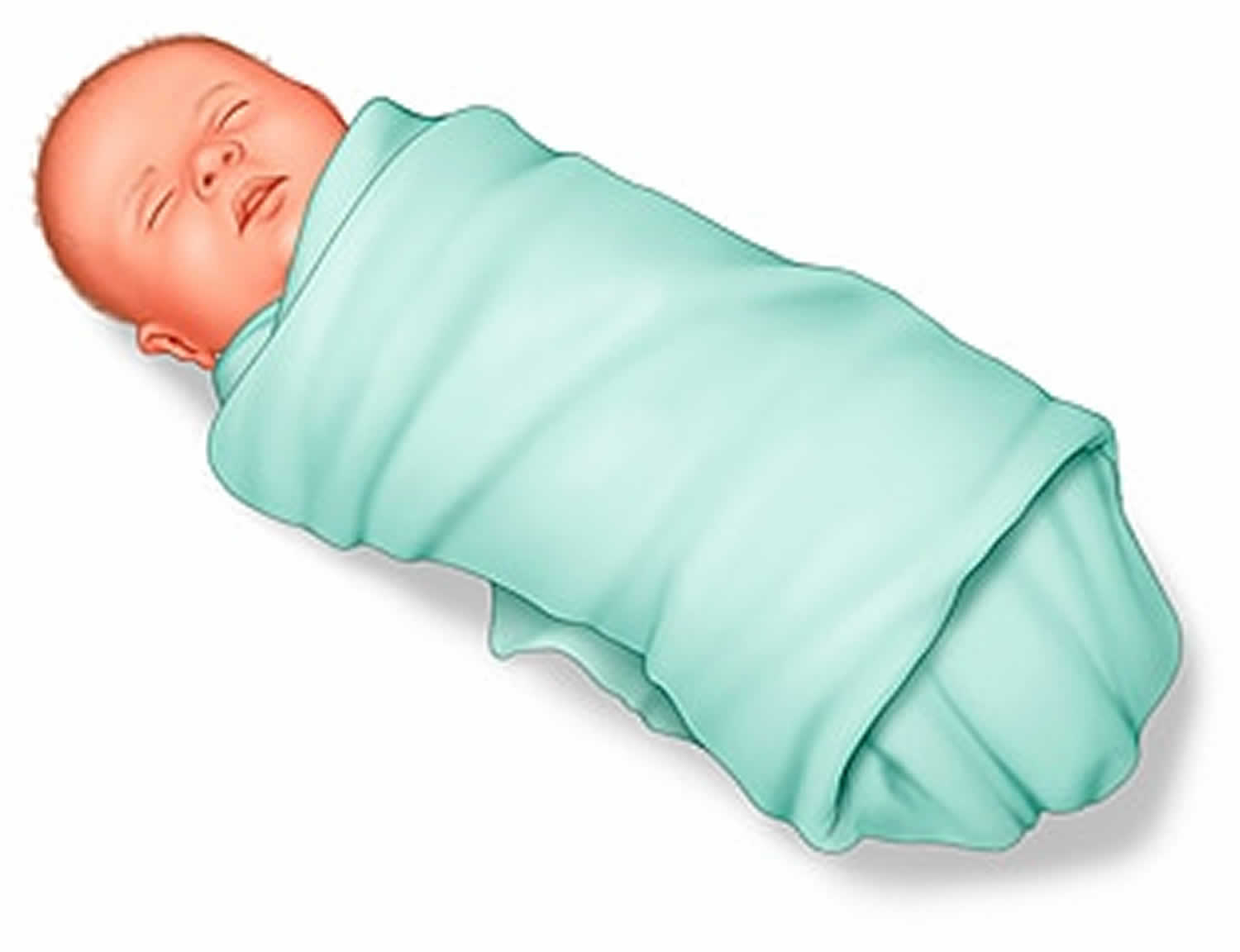Contents
Swaddling baby
Swaddling is a technique of wrapping a blanket snuggly around your baby’s body in order to resemble the mother’s womb and help soothe a newborn baby. Research shows that swaddling, a technique that mimics the coziness of the womb — can keep your baby warm and secure, as well as possibly calm a baby with colic. New parents often learn how to swaddle their infant from the nurses in the hospital. Some experts feel that swaddling in the early weeks can help newborns sleep more comfortably on their backs. This can help minimize the startle reflex and ease colic symptoms in some babies. If you choose to swaddle, take time to learn how to swaddle properly before you leave the hospital. When swaddling isn’t done properly, however, it can pose risks for your baby. Take care not to swaddle too loosely, as the blanket can come loose and accidently suffocate your baby. Take care not to swaddle too tightly as this can compress your baby’s chest and make it difficult to breathe. Tight swaddling can also cause problems with your baby’s hips and legs. Once your baby starts to wiggle around during sleep, it is probably time to stop swaddling.
Is swaddling safe?
The American Academy of Pediatrics says that when done correctly, swaddling can be an effective technique to help calm infants and promote sleep 1). It is fine to swaddle your baby. However, make sure that the baby is always on his or her back when swaddled. The swaddle should not be too tight or make it hard for the baby to breathe or move his or her hips. When your baby looks like he or she is trying to roll over, you should stop swaddling.
The 2 most important things to remember about safe sleep practices:
- Healthy babies are safest when sleeping on their backs at nighttime and during naps. Side sleeping is not as safe as back sleeping and is not advised.
- Tummy time is for babies who are awake and being watched. Your baby needs this to develop strong muscles.
If you plan to swaddle your infant at home, you need to follow a few guidelines. To reduce the risk of Sudden Infant Death Syndrome (SIDS), it’s important to place your baby to sleep on his back, every time you put him to sleep. This may be even more important if your baby is swaddled. Some studies have shown an increased risk of SIDS and accidental suffocation when babies are swaddled if they are placed on their stomach to sleep, or if they roll onto their stomach.
American Academy of Pediatrics Safe Sleep Recommendations
The American Academy of Pediatrics recommends parents follow the safe sleep recommendations every time they place their baby to sleep for naps or at nighttime:
- Place your baby on her back to sleep, and monitor her to be sure she doesn’t roll over while swaddled.
- Do not have any loose blankets in your baby’s crib. A loose blanket, including a swaddling blanket that comes unwrapped, could cover your baby’s face and increase the risk of suffocation.
- Use caution when buying products that claim to reduce the risk of Sudden Infant Death Syndrome (SIDS). Wedges, positioners, special mattresses and specialized sleep surfaces have not been shown to reduce the risk of SIDS, according to the American Academy of Pediatrics.
- Your baby is safest in her own crib or bassinet, not in your bed.
- Swaddling can increase the chance your baby will overheat, so avoid letting your baby get too hot. The baby could be too hot if you notice sweating, damp hair, flushed cheeks, heat rash, and rapid breathing.
- Consider using a pacifier for naps and bedtime.
- Place the crib in an area that is always smoke-free.
How to keep your sleeping baby safe
Until their first birthday, babies should sleep on their backs for all sleep times—for naps and at night. Experts know babies who sleep on their backs are much less likely to die of Sudden Infant Death Syndrome (SIDS) than babies who sleep on their stomachs or sides. The problem with the side position is that the baby can roll more easily onto the stomach. Some parents worry that babies will choke when on their backs, but the baby’s airway anatomy and the gag reflex will keep that from happening. Even babies with gastroesophageal reflux (GERD) should sleep on their backs.
Newborns should be placed skin-to-skin with their mother as soon after birth as possible, at least for the first hour. After that, or when the mother needs to sleep or cannot do skin-to-skin, babies should be placed on their backs in the bassinet. While premature babies may need to be on their stomachs temporarily while in the NICU due to breathing problems, they should be placed on their backs after the problems resolve, so that they can get used to being on their backs and before going home.
Some babies will roll onto their stomachs. You should always place your baby to sleep on the back, but if your baby is comfortable rolling both ways (back to tummy, tummy to back), then you do not have to return your baby to the back. However, be sure that there are no blankets, pillows, stuffed toys, or bumper pads around your baby, so that your baby does not roll into any of those items, which could cause blockage of air flow.
If your baby falls asleep in a car seat, stroller, swing, infant carrier, or sling, you should move him or her to a firm sleep surface on his or her back as soon as possible.
Use a firm sleep surface. A crib, bassinet, portable crib, or play yard that meets the safety standards of the Consumer Product Safety Commission (CPSC) is recommended along with a tight-fitting, firm mattress and fitted sheet designed for that particular product. Nothing else should be in the crib except for the baby. A firm surface is a hard surface; it should not indent when the baby is lying on it. Bedside sleepers that meet Consumer Product Safety Commission safety standards may be an option, but there are no published studies that have examined the safety of these products. In addition, some crib mattresses and sleep surfaces are advertised to reduce the risk of SIDS. There is no evidence that this is true, but parents can use these products if they meet Consumer Product Safety Commission safety standards.
Room share—keep baby’s sleep area in the same room where you sleep for the first 6 months or, ideally, for the first year. Place your baby’s crib, bassinet, portable crib, or play yard in your bedroom, close to your bed. The American Academy of Pediatrics recommends room sharing because it can decrease the risk of SIDS by as much as 50% and is much safer than bed sharing. In addition, room sharing will make it easier for you to feed, comfort, and watch your baby.
Only bring your baby into your bed to feed or comfort. Place your baby back in his or her own sleep space when you are ready to go to sleep. If there is any possibility that you might fall asleep, make sure there are no pillows, sheets, blankets, or any other items that could cover your baby’s face, head, and neck, or overheat your baby. As soon as you wake up, be sure to move the baby to his or her own bed.
Never place your baby to sleep on a couch, sofa, or armchair. This is an extremely dangerous place for your baby to sleep.
Bed-sharing is not recommended for any babies. However, certain situations make bed-sharing even more dangerous. Therefore, you should not bed share with your baby if:
- Your baby is younger than 4 months old.
- Your baby was born prematurely or with low birth weight.
- You or any other person in the bed is a smoker (even if you do not smoke in bed).
- The mother of the baby smoked during pregnancy.
- You have taken any medicines or drugs that might make it harder for you to wake up.
- You drank any alcohol.
- You are not the baby’s parent.
- The surface is soft, such as a waterbed, old mattress, sofa, couch, or armchair.
- There is soft bedding like pillows or blankets on the bed.
Keep soft objects, loose bedding, or any objects that could increase the risk of entrapment, suffocation, or strangulation out of the baby’s sleep area. These include pillows, quilts, comforters, sheepskins, blankets, toys, bumper pads or similar products that attach to crib slats or sides. If you are worried about your baby getting cold, you can use infant sleep clothing, such as a wearable blanket. In general, your baby should be dressed with only one layer more than you are wearing.
Try giving a pacifier at nap time and bedtime. This helps reduce the risk of SIDS, even if it falls out after the baby is asleep. If you are breastfeeding, wait until breastfeeding is going well before offering a pacifier. This usually takes 2-3 weeks. If you are not breastfeeding your baby, you can start the pacifier whenever you like. It’s OK if your baby doesn’t want a pacifier. You can try offering again later, but some babies simply don’t like them. If the pacifier falls out after your baby falls asleep, you don’t have to put it back in.
Recommendations for prenatal and postnatal
- Do not smoke during pregnancy or after your baby is born. Keep your baby away from smokers and places where people smoke. If you are a smoker or you smoked during pregnancy, it is very important that you do not bed share with your baby. Also, keep your car and home smoke-free. Don’t smoke anywhere near your baby, even if you are outside.
- Do not use alcohol or illicit drugs during pregnancy or after the baby is born. It is very important not to bed share with your baby if you have been drinking alcohol or taken any medicines or illicit drugs that can make it harder for you to wake up.
- Breastfed babies have a lower risk of SIDS. Breastfeed or feed your baby expressed breast milk. The AAP recommends breastfeeding as the sole source of nutrition for your baby for about 6 months. Even after you add solid foods to your baby’s diet, continue breastfeeding for at least 12 months, or longer if you and your baby desire.
- Schedule and go to all well-child visits. Your baby will receive important immunizations at these doctor visits. Recent evidence suggests that immunizations may have a protective effect against SIDS.
- Make sure your baby has tummy time every day. Awake tummy time should be supervised by an awake adult. This helps with baby’s motor development and prevents flat head syndrome.
- There are ways to reduce the risk of the baby developing a flat spot:
- Alternate which end of the crib you place the baby’s feet. This will cause her to naturally turn toward light or objects in different positions, which will lessen the pressure on one particular spot on her head.
- When the baby is awake, vary her position. Limit time spent in freestanding swings, bouncy chairs, and car seats. These items all put added pressure on the back of the baby’s head.
- Spend time holding the baby in your arms as well as watching her play on the floor, both on her tummy and on her back.
- A breastfed baby would normally change breasts during feeding; if the baby is bottle fed, switch the side that she feeds on during feeding.
- There are ways to reduce the risk of the baby developing a flat spot:
Use caution when buying products
Use caution when a product claims to reduce the risk of SIDS. Wedges, positioners, special mattresses and specialized sleep surfaces have not been shown to reduce the risk of SIDS, according to the American Academy of Pediatrics.
Do not rely on home heart or breathing monitors to reduce the risk of SIDS. If you have questions about using these monitors for other health conditions, talk with your pediatrician.
There isn’t enough research on bedside or in-bed sleepers. The AAP can’t recommend for or against these products because there have been no studies that have looked at their effect on SIDS or if they increase the risk of injury and death from suffocation.
How to swaddle a baby
To safely swaddle your baby, follow these tips.
How to swaddle correctly:
- To swaddle, spread the blanket out flat, with one corner folded down.
- Lay the baby face-up on the blanket, with her head above the folded corner.
- Straighten her left arm, and wrap the left corner of the blanket over her body and tuck it between her right arm and the right side of her body.
- Then tuck the right arm down, and fold the right corner of the blanket over her body and under her left side.
- Fold or twist the bottom of the blanket loosely and tuck it under one side of the baby.
- Make sure her hips can move and that the blanket is not too tight. You want to be able to get at least two or three fingers between the baby’s chest and the swaddle.
Keep baby’s hips loose
Babies who are swaddled too tightly may develop a problem with their hips. Studies have found that straightening and tightly wrapping a baby’s legs can lead to hip dislocation or hip dysplasia, an abnormal formation of the hip joint where the top of the thigh bone is not held firmly in the socket of the hip.
Getting started
To place your baby in a swaddle, spread out a blanket and slightly fold over one corner. Lay your baby face-up on the blanket, placing his or her head at the edge of the folded corner. While holding your baby in place, pick up one corner of the blanket. Bring the blanket across your baby’s body. Tuck the blanket beneath him or her.
Figure 1. Swaddling – getting started
Covering baby’s feet
Fold the bottom point of the blanket up over the baby’s feet.
Figure 2. Swaddling – covering baby’s feet
Completing the swaddle
While holding your baby in place, pick up the other corner of the blanket and wrap it across your baby’s body. The swaddle will leave only your baby’s head and neck exposed.
Don’t rigidly extend your baby’s legs or make the swaddle too tight. Swaddling a baby in a way that prevents his or her hips or knees from being able to move freely within the blanket can lead to developmental dysplasia of the hip — a condition in which the hip joint has not formed normally and might be easy to dislocate.
Figure 3. Swaddling – completing the swaddle
Keeping a swaddled baby safe
Once you’ve swaddled your baby, be sure to practice safe sleep habits. Always place a swaddled baby on his or her back to sleep. Stop swaddling when your baby learns to roll onto his or her stomach.
If you have questions about how to safely swaddle your baby, consult your baby’s doctor.
Figure 4. Swaddling – keeping a swaddled baby safe
When to stop swaddling a baby?
Experts recommend parents stop swaddling by age 2 months, before the baby intentionally starts to try to roll. By about three months old swaddling should have been phased out because the babies are more active and rolling If babies are swaddled, they should be placed only on their back and monitored so they don’t accidentally roll over.
Parents should know that there are some risks to swaddling. Swaddling may decrease a baby’s arousal, so that it’s harder for the baby to wake up. That is why parents like swaddling – the baby sleeps longer and doesn’t wake up as easily. But experts know that decreased arousal can be a problem and may be one of the main reasons that babies die of SIDS.
References [ + ]









